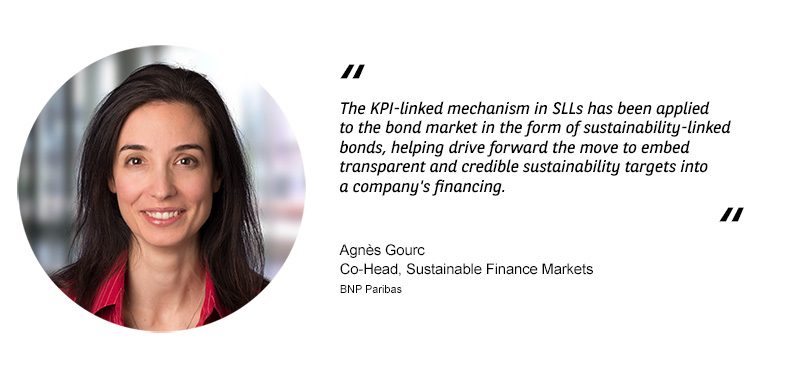The evolution of transition finance
Transition finance has come a long way since its inception, with a diverse set of instruments to support issuers in achieving their sustainability targets, including US$488bn in sustainable bonds and €200bn in sustainability-linked loans (SLLs).| What is a sustainability-linked bond? Sustainability-linked bonds embed an environmental, social and governance (ESG)-related key performance indicator (KPI) that issuers commit to achieve, accruing additional payments to bondholders should they fall short. Unlike green or sustainable bonds, the funds raised with this instrument are not tagged to a specific use of proceeds but for general corporate purposes. This type of bond aims to further underpin the key role that debt markets can play in funding and inspiring companies that contribute to sustainability from an ESG perspective. SLBs have five core components: a credible KPI; ambitious sustainability performance targets; meaningful changes in bond characteristics; verification and reporting. By complementing green, social, sustainability and transition bonds, SLBs should enable more issuers to tap the sustainable financing market and scale up decarbonisation, while serving a broader range of investors. |
Sustainability-linked bonds (SLBs), many of which are linked to science-based targets today, are growing in popularity in recent months. This is in addition to the broader spectrum of sustainable financing instruments, for example sustainability-linked loans or sustainability-linked hedges such as the first issued by Hysan Development in Hong Kong.
There is still a long way to go though, and the urgency of decarbonising emissions intensive industries is of utmost importance given the scale of the climate crisis. Science-based targets in sustainability-linked bonds are a key mechanism in bringing investors along the corporate transition journey because they add credibility, transparency and accountability.
Science-based targets provide companies more specific goals and a practical road map to efficiently help limit global warming to 1.5°C by providing clear action plans in the companies’ strategies to reduce their greenhouse gas emissions.

Who is using science-based targets within sustainability-linked bonds and why?
Corporates from a range of different sectors have started using sustainability-linked bonds, including the following transactions which BNP Paribas supported:|
Italian energy group ENEL
marked the beginning of the SLB market in September 2019 and chose to link
its bonds to the United
Nations Sustainable Development Goal (SDG) 7, to ensure access to affordable, reliable,
sustainable and modern energy for all. ENEL set a
target to increase its renewable energy installed capacity to 55% (from 46% as
of H1 2019) of total capacity by the end of 2021 while reducing its CO2 specific emissions to 0.23 kg/ kWheq by 2030 and reach decarbonisation by 2050. On top of issuing
several similar bonds in different currencies, it also innovated by launching
a sustainability-linked
share buyback programme – including a SDG
reward mechanism embedded in the price at which the company purchases its own
shares linked to a target KPI “The value of sustainability has been reflected in the demand mechanics and the pricing of the issue, enabling Enel to obtain a financial advantage equal to 20 bps compared with an issue of bonds without sustainability feature,” explained ENEL in its media release. |
|
In
September 2020, CHANEL was the first unrated issuer to place public bonds
linked to sustainability metrics, leading the way towards a more
sustainable luxury sector. Its sustainability targets included decreasing
CHANEL’s own absolute (scope 1 and 2) emissions by 50% by 2030 (from a 2018
base year), reducing its supply chain and other scope 3-related greenhouse gas
emissions by 10% by 2030 (from a 2018 base year), and shifting to 100%
renewable electricity in the company’s operations by 2025. Philippe Blondiaux, CHANEL’s Chief Financial Officer, said: “In launching these bonds, CHANEL hopes to support the development of the sustainable financing market and the wider social and environmental progress that this type of financing can advance. There is a growing recognition amongst investors that they have a role to play in helping to tackle climate change, and we look forward to engaging with them.” |
In November 2020, French multinational
company Schneider
Electric issued the first sustainability-linked convertible bond, a zero-coupon bond that offers investors a premium
in case the company underperforms sustainability objectives. Its three KPIs
focus on:
|
Investors played a significant role in the SLB market’s development: the measurable, trackable and verified metrics that the SLBs embed appeal to investors, as they are additional proof of a company’s commitment and credibility.
What’s next for science-based targets and sustainability-linked bonds?
The International Capital Market Association (ICMA) – which aims to build a common language within sustainable capital markets – released the Sustainability-Linked Bond Principles (SLBP) in early June. The SLBPs provide guidelines for issuing these securities with structuring features, disclosure and reporting recommendations. They can be used by all types of issuers and are designed to bring credibility, transparency and progressive ambition to SLBs.In September 2020, the European Central Bank announced that it would accept SLBs as collateral and that it could start buying them under its asset purchase programmes.
In order to progress the science-based approach, collaboration with industry experts is key. Many corporates are collaborating with scientists on disclosures, and the Science Based Targets Initiative – which strives for increased disclosure and transparency of corporate climate ambitions – has so far grown to include over 1,000 companies reporting.
SLBs may be new but they have already given more issuers the opportunity to finance their transition towards a low-carbon economy by accessing a wider pool of ESG investors.
Growing and harmonising the sustainable bond market
|